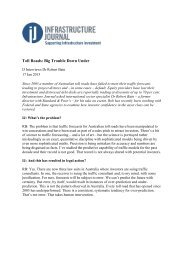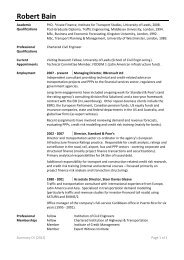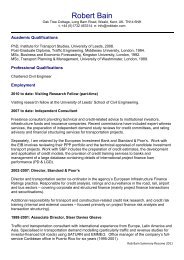Disincentivising overbidding for toll road concessions
Disincentivising overbidding for toll road concessions
Disincentivising overbidding for toll road concessions
- No tags were found...
Create successful ePaper yourself
Turn your PDF publications into a flip-book with our unique Google optimized e-Paper software.
DISINCENTIVISING OVERBIDDING FOR TOLL ROAD CONCESSIONS<br />
In the context of cost-side bias, Flyvbjerg and COWI (2004) recommended that the UK DfT use optimism uplifts<br />
based on empirical evidence from reference classes in the tendering process. For <strong>road</strong> projects, a reference class of<br />
172 <strong>road</strong> projects was applied (of which 128 were in Britain). The size of the uplift was determined with reference to<br />
these comparator projects and as a decreasing function of the willingness of the DfT to accept risk. Typically, the DfT<br />
looks to ensure that the risk of cost overrun is less than 20%. For the construction of <strong>road</strong>s, this results in an uplift on<br />
<strong>for</strong>ecast costs of 32%.<br />
The potential <strong>for</strong> reference class <strong>for</strong>ecasting has been reflected in HM Treasury’s Green Book since 2003:<br />
There is a demonstrated, systematic, tendency <strong>for</strong> project appraisers to be overly optimistic. To redress this<br />
tendency appraisers should make explicit, empirically based adjustments to the estimates of a project’s costs,<br />
benefits, and duration...it is recommended that these adjustments be based on data from past projects or similar<br />
projects elsewhere. 71<br />
Optimism bias uplifts have since been used in numerous transport infrastructure projects in the UK, including the<br />
Crossrail project in London and the Edinburgh Trams Line 2 proposal (where an uplift of £145m was given to the<br />
<strong>for</strong>ecast). 72 The reference class <strong>for</strong>ecasting model has also been endorsed by the American Planning Association<br />
(APA):<br />
APA encourages planners to use reference class <strong>for</strong>ecasting in addition to traditional methods as a way to<br />
improve accuracy. The reference class <strong>for</strong>ecasting method is beneficial <strong>for</strong> non-routine projects such as stadiums,<br />
museums, exhibit centers, and other local one-off projects. Planners should never rely solely on civil engineering<br />
technology as a way to generate project <strong>for</strong>ecasts. 73<br />
The benefits of reference class <strong>for</strong>ecasting are likely to be greater in situations where bias is a result of optimism<br />
rather than strategic behaviour. Moreover, the Edinburgh trams example highlights that, even after adjustments<br />
are applied, <strong>for</strong>ecasts can still vary widely from outturn costs or patronage. 74 In the case of the <strong>toll</strong> <strong>road</strong>s sector,<br />
which is still in the early stages of its life cycle, there may be difficulties in determining a suitable reference class<br />
<strong>for</strong> comparison.<br />
Menu-based appraisal<br />
This section briefly introduces the notion of appraising bids on the basis of a ‘menu’ of options. The idea behind<br />
menu-based appraisal, explained in more detail in a case study in section 4, is to elicit truthful revelation of costs<br />
by presenting bidders with a choice of options. The motivation <strong>for</strong> this approach can be considered by exploring the<br />
notion of an incentive, and of ‘incentive compatibility’.<br />
One of the problems with the current procurement process in the <strong>toll</strong> <strong>road</strong>s sector is that bid appraisal effectively<br />
comes down to who offers the highest upfront premium. As such, truthful revelation of patronage estimates is not<br />
incentive-compatible—that is, bidding consortia have incentives to provide high estimates rather than accurate ones.<br />
Box 2.4 Identifying and defining an incentive<br />
In everyday language, an incentive is a factor that encourages and motivates someone to follow a particular<br />
course of action; any decision that individuals (or companies) make consists of weighing different options and<br />
picking the one that yields the highest benefit. The decision process of firms there<strong>for</strong>e involves comparing the<br />
benefits associated with different actions (at the same time, any project is compared with the firm’s outside<br />
option; namely, not to take any new action). This concept is captured by the incentive-compatibility constraint,<br />
which means that actions will not be undertaken where they do not result in net benefits to the party undertaking<br />
the action.<br />
71 HM Treasury (2003), ‘Supplementary Green Book Guidance – Optimism Bias’.<br />
72 See, <strong>for</strong> example, Ove Arup & Partners Scotland (2004), ‘Scottish parliament, Edinburgh tram line 2 review of business case’; Flyvbjerg,<br />
B (2006), ‘From Nobel Prize to Project Management: Getting Risks Right’, Project Management Journal, 37:3, 5–15.<br />
73 American Planning Association (2005), ‘APA article calls on planners to help end inaccuracies in public project revenue <strong>for</strong>ecasting’, cited in<br />
Flyvbjerg (2008), op. cit.<br />
74 The project has been subject to significant time and cost overruns after a contractual dispute between Transport Initiatives Edinburgh and the<br />
Bilfinger Berger Siemens consortium that was tasked with delivering the project. See, <strong>for</strong> example, Audit Scotland (2011), ‘Edinburgh trams –<br />
interim report’, prepared <strong>for</strong> the Auditor General <strong>for</strong> Scotland and the Accounts Commission, February 2nd.<br />
26






